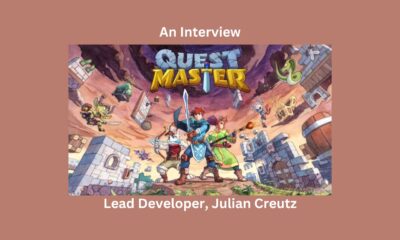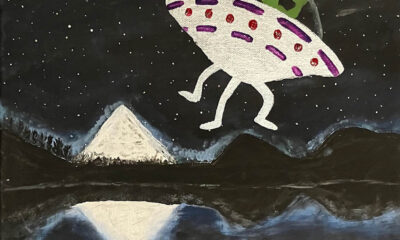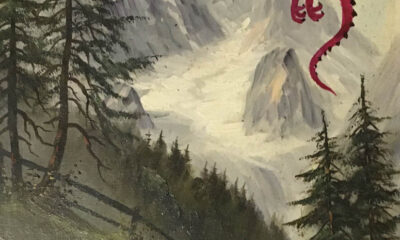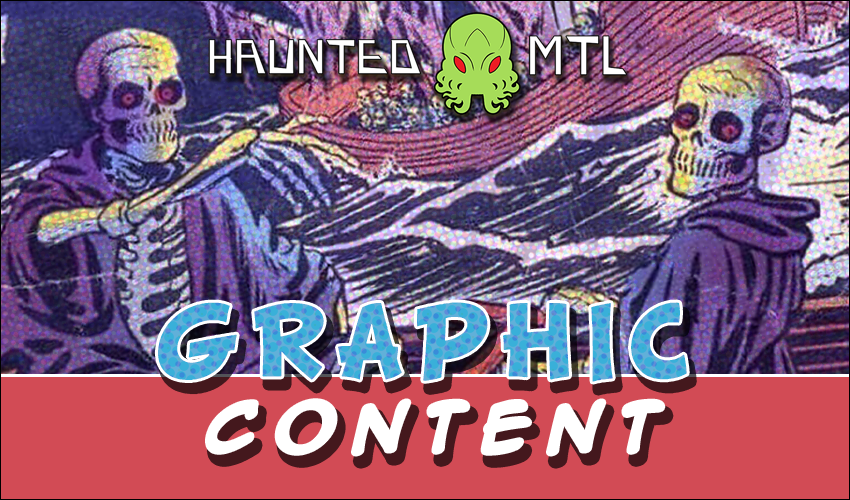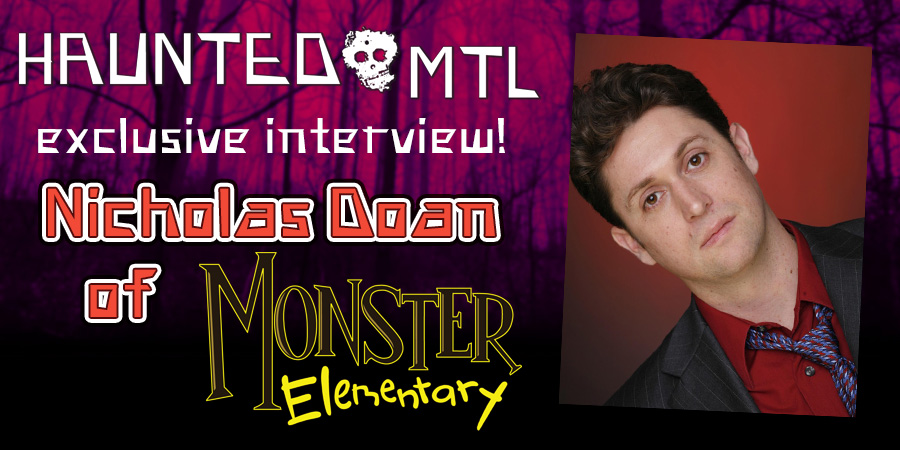
Interview: Nicholas Doan of “Monster Elementary”
Growing up can be tough and it can be even tougher when you’re a monster-kid stuck in the human world. That’s the central idea of Monster Elementary, an adorable, all-ages horror comedy comic created by Nicholas Doan and Caanan Grall. We’re usually a bit on the darker side here on Haunted MTL, but many of us fell in love with horror through kid-friendly concepts to introduce us to our future favorite monsters, and Monster Elementary is doing just that for a whole new generation.
Monster Elementary is a fun, witty, comedy/adventure comic for children of all ages featuring five monster children based on classic monster movie archetypes. These five monster kids are forced to attend a human public school after their monsters-only private school is raided by the FBI. To their surprise, they’re not allowed to eat any of the other students. The monsters’ adventures and experiences hiding their identities and growing up are the focal point of the book.
We met writer Nicholas Doan at WonderCon 2019 in Anaheim and asked to talk to him about Monster Elementary. We also have some previews of the comics, so be sure to read to the end!
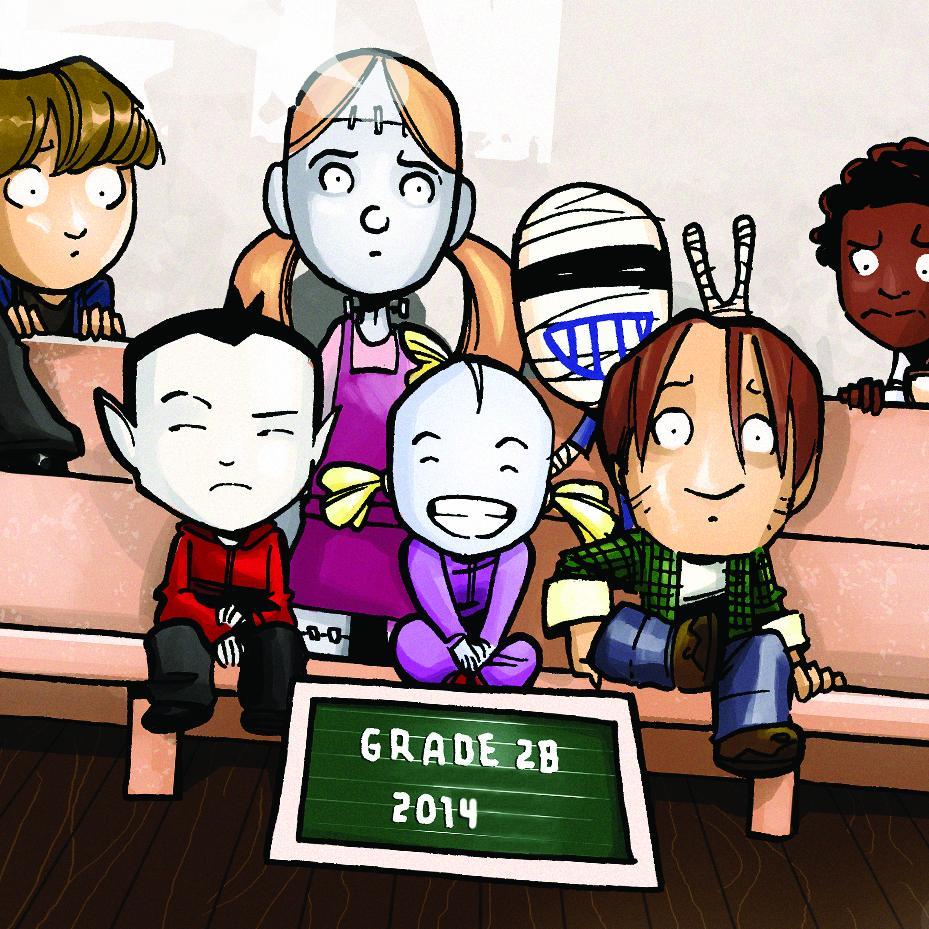
So, Nicholas, what influences you as a writer?
Nicholas: I’m mostly influenced by the things that I enjoyed as a kid. That mostly means the cartoons and comic books of the 80’s. Superman comic books especially. The writers that have had the most profound effect on me are Charles Schulz, William Goldman and Mark Waid. I think if you look for it, you can really see Schulz’ influence on Monster Elementary.
You have a very diverse writing background, such as being part of the Dramatists Guild and having been a winner of the DC/Zuda webcomic program; does the diversity of writing experience have any surprising benefits to you when writing Monster Elementary?
Nicholas: There are definitely benefits. Writing for Theatre and writing a webcomic for DC are two experiences that heavily affected who I am as a writer. Writing for theatre is very limiting. There are no car crashes or elaborate set pieces, Theatre forces you to focus on character and dialogue. As a Playwright, I found that I wanted all of my dialogue to be interesting and not just informative. When I was writing Pray For Death for DC Comics’ web imprint, Zuda, I learned a lot about how tell a story in a serialized comic book format. Most importantly, how to write 4 page chunks of a story that feel like a satisfying read in themselves, but still add to the greater story. I learned a lot about plotting a comic story as well. Zuda really was a crash course in what works in comics and since it was part of an online community, you always got immediate feedback on what works and what doesn’t.
You work on Monster Elementary with your wife, Gwendolyn, but do you both particularly love horror? Or is it more of a situation with one of you being a horror fan?
Nicholas: We both love Halloween! I think Monster Elementary really celebrates the spirit of Halloween just as much as it celebrates classic horror. While I love horror films and media, my wife does not enjoy being frightened. That’s why Monster Elementary is great for her and people like her. Over the years, Halloween has become more and more of an adult holiday, but we need to remember that it is a day for kids to engage in some of the spookier elements and for everyone to have fun. I like that Monster Elementary can serve as an introduction to horror for kids or a safe haven for adults that don’t want to be terrified. I also like making Halloween part of my everyday life.
What is your favorite horror story?
Nicholas: I think the Frankenstein story is one of the most poignant, powerful and rife for reinvention in all of horror. That being said, Peter Jackson’s The Frighteners is my favorite movie and I think Stephen King’s IT is one of the best horror movies ever. And I can’t wait to see the sequel!
What type of monster would you be if you found yourself in your comic?
Nicholas: I would be the Mad Scientist reinventing all of these monsters for another generation to be entertained by them.
How hard is it to work within horror themes but still maintain something tonally for a general audience?
Nicholas: It’s really easy for me. I love classic horror. The horror classics are my own personal cannon for the series and the classics never really got too scary. At least not in terms of what a modern audience expects. And at the root of it all, I just want to have fun and help others to have fun with me. This is why I will keep doing Monster Elementary for as long as possible.
How do you go about choosing an artist for a Monster Elementary story?
Nicholas: I seek out artists that have their own unique style. Comics should showcase art. I never want to use a house style, I want every artist I work with to put their own unique stamp on my characters.
Do you have any upcoming events or news you’d like to share?
Nicholas: I’ll be at Phoenix Fan Fusion from May 23-26. Then I’ll be doing as singing at Astro Zombies comic shop in Albuquerque May 29. That’ll be followed up by Denver Comic-Con May 31- June 2. We then hit San Diego Comic-Con July 17-21 and wrap up at Midsummer Scream in Long Beach August 3-4.
Anything else you want us to keep an eye out for?
Nicholas: Also keep an eye on Monster Elementary‘s Facebook page and Twitter feed for news on our upcoming Kickstarter campaign to fund the third book in the series!
Image Gallery
Enjoy these wonderful glimpses at the diverse array of art and stories in volumes 1 and 2 of Monster Elementary.






Book Reviews
A Stellar Debut Novel, We Used To Live Here
Imagine this. You’re home alone, waiting for your partner to return, when you hear a knock on your door. You answer it to see a family of five, bundled up against the cold. The father, a kindly older gentleman, explains that he used to live in this house as a boy. And he would love to show it to his family.
Do not let them in.
The story
Released in June 2024, We Used To Live Here is author Marcus Kliewer’s debut novel. It tells the story of Eve, who just purchased a beautiful house with her partner, Charlie. Their plan is to flip the house and sell it.
One night, while waiting for Charlie to come home, Eve is surprised by a knock at the door. It’s a man named Thomas Faust and his family.
Thomas explains that he grew up in the house and hasn’t been in the area in years. Would Eve let them in so that he can show the home to his children?
Against her better judgment, Eve lets them in. She regrets this almost at once when Thomas’s daughter vanishes somewhere into the house.
What worked
I always appreciate a book that allows you to play along with the mystery. And this book does that better than just about any other I’ve seen.
Pay close attention to the chapters, to the words that aren’t there. To everything about this novel.
This is mostly down to Kliewer. This is ultimately his work of art. But the production value is also fantastic. I don’t want to ruin the multiple mysteries, so I’ll just say this. There are clues in this book that require some specific artistic choices in the page layouts in this book. And I loved that.
If you’d like to experience another horror book review, check out this one.
We Used To Live Here is also the kind of story that makes you question everything right along with the main character, Eve. Eve is a great main character. But she might be an unreliable narrator. She might be experiencing every single horror described, exactly as it’s described. Or, she might be having a psychotic breakdown. Through most of the book, we can’t be sure. And that is so much fun.
Finally, the weather plays a large part in this story. There are several stories in which the weather or the land itself could be considered a character. Even an antagonist. This is certainly one. The winter storm is the thing that traps the family in the house with Eve. It also makes escaping the home difficult. Reading this book during the winter was especially impactful. Most of us know what it feels like to be shut in by a storm. I’ve personally lived through some of those storms that are just referred to by their year, as though they were impactful enough to claim the whole 365 days for themself. And that was with people I liked. Imagine what it would feel like with strangers. It’s a staggering thought and one that we explore in depth in this book.
In the end, We Used To Live Here is a fantastic book. It’s the sort of story that sneaks into your brain and puts down roots. And if this is just the first book we’re getting from Kliewer, I can’t wait to see what else he comes up with.
 (5 / 5)
(5 / 5)
Book Reviews
Exploring real terror with The House of My Mother
As a disclaimer, this is a review of The House of My Mother from a critical perspective. I will not be discussing my opinions of the legal case against Ruby Franke and Jody Hildebrandt. I will be discussing the merits of the book as a work of true crime alone.
In 2015, Ruby Franke started a YouTube channel called 8 Passengers. In August of 2023, Franke and her business associate Jodi Hildebrandt were arrested for, and later plead guilty to, charges of aggravated child abuse. And in January of this year, Shari Franke told her story in The House of My Mother.
The story
The House of My Mother is the true story of Shari Franke, the oldest child of one of the most famous family vlogger families.
As a child, Shari came to the conclusion that her mother didn’t like her. Soon, she began to fear her mother’s anger.
Things got significantly worse when Ruby started their family vlog. All of the families most intimate moments were splashed across the internet for anyone to watch. This became a living nightmare for Shari.
Of course, that was only the start of the family nightmare. Because Ruby was about to meet someone who would reinforce all of the darkest parts of herself.
Eventually Shari manages to escape her home. But her younger siblings were still in her mother’s clutches. She had to save them, and her father, from the monster her mother had become.
What worked
Through the book, Shari only ever mentions the name of one of her siblings, Chad. This is because Chad is the only of her siblings that is an adult at the time of the publication.
There are children involved in this story. Children who’s lives and privacy have already been damaged. Shari didn’t want to do that to them again, and neither do I.
It probably won’t surprise you that this book is full of upsetting details. But not in the way you might imagine.
Nowhere in this book will you find gory details about the abuse the Franke kids suffered. And I consider that a good thing. Those sort of details are all fun and games when we’re talking fiction. When it’s real kids who are really living with the damage, it’s not a good time.
What you’ll find instead is a slew of more emotionally devastating moments. One that stuck with me is when Ruby’s mother gives her a pair of silk pajamas as a gift after Ruby gave birth to one of her babies. Shari asks Ruby if she’d bring her silk pajamas when she had a baby. Ruby responds that yes, when Shari becomes a mother they can be friends.
What a lovely way to make a little girl feel like she’s not worth anything unless she reproduces. And, if she does decide to have children, who is going to bring her silk pajamas?
In the end, this isn’t a story about ghosts or demons. It’s not about a serial killer waiting on a playground or in the attic of an unsuspecting family. Instead, this is a story about things that really keep us up at night. It’s the story of a woman so obsessed with perfection that she drove away her eldest daughter. The story of a young woman who’s forced to watch from afar as her beloved brothers and sisters are terrorized and abandoned. These are the sorts of things that really keep us up at night. These are the real nightmares.
More than that, though, The House of My Mother is a story of survival. It’s about a family that was ripped apart and somehow managed to stitch itself back together again. It’s about a brave young woman who managed to keep herself safe and sane in the face of a nightmare. If you haven’t read it yet, I can’t recommend it enough.
For more like this, check out my review of Shiny Happy People.
 (5 / 5)
(5 / 5)
Book Reviews
Book Review of Boreal: an Anthology of Taiga Horror
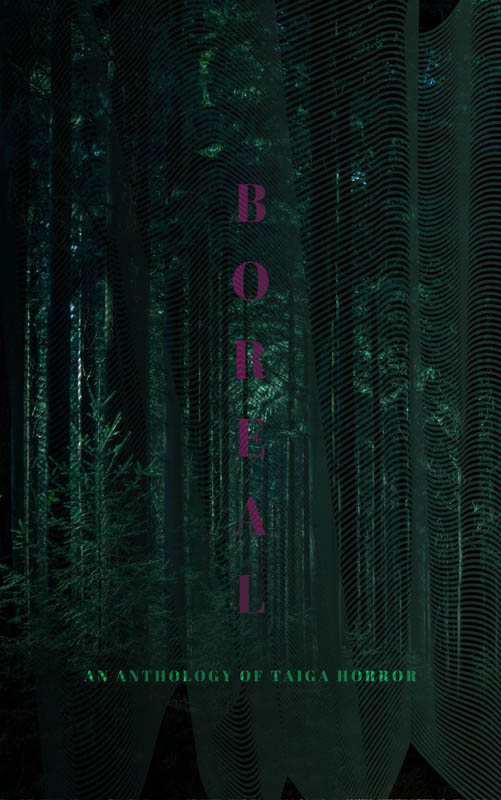
Boreal: an Anthology of Taiga Horror is a collection of twenty-two haunting tales that dwell in the deepest darkest woods and frozen wastelands, edited by Katherine Silva and including Haunted MTL’s very own Daphne Fauber. Each story has even been gifted with its very own poster, hinting at the horrors to be found within it, bestowing a beautiful visual collection as well.
The tales are varied and touch upon the environment in new and different ways, each hearkening to a sort of epiphany or raised awareness. These stories exude both dread and wonder at the smallness of our human existence in contrast to the sacred world we have isolated from, sheltering ourselves in our comfortable houses with centralized heat and everything we could possibly need or want at the ready. The taiga becomes a sanctuary outside of our own dulled awarenesses. It is a holy place imbued with powers beyond mortal human reach, a wilderness that threatens to swallow us – both whole and bit by bit, simultaneously.
The protagonists enter into this realm through ritual, superstition, longing, stubbornness, and their own hubris – yearning to survive its dangers, and to make their own marks upon it. The starkness of their surroundings harbors delicate moments that would be all too easily missed if not deliberately sought or pointed out. The softness of fur, the dappled sunlight shining through trees, the hazy clouds of breath forming in crisp air, the brittleness of bleached bone… those quiet experiences that beg to be forgotten, to lay safely sleeping just below the frozen surface, awaiting spring.
There are those who followed in the footsteps of their predecessors, seeking to escape the constraints of their parent’s and elders’ indoctrination, traditions, madness, and abuse, yearning to find their own way despite also being inextricably bound to their own pasts. There are those who just wanted to go for a walk in the woods, and remained forever changed by what they experienced. There are those who wished to impose their will upon the wilderness, their order falling to disarray, unable to make lasting impact. There are those who sought to leave behind the world of mankind, looking for oneness in the natural order of things through isolation, leaving a bit of themselves behind after being consumed by the terrors they encountered. There are those who truly found communion with the woods, became one with its wildness, and invited its spirit into their hearts to find peace, even at cost of their own lives. And then, there are the spirits themselves…
 (3 / 5)
(3 / 5)
All in all, I give Boreal: an Anthology of Taiga Horror 3.0 Cthulhus. I love existential angst so I found it to be an enjoyable read, and I appreciated the myriad manners in which the biome was explored. But there were points in which I found myself struggling to follow along, as if the words were swept up into their own wilds in ways that alienated myself as reader, as if my mere voyeurism into this otherworldly place was not enough to comprehend the subtle deviations in storytelling mannerisms fully. I suppose in some sense this seems appropriate, but at the same time, it left me feeling a bit unfulfilled, as if I had missed a spiritual connection that should have resonated more deeply.




